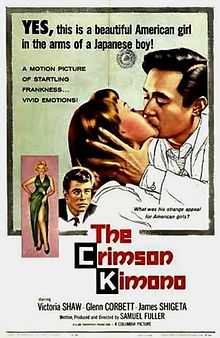The Crimson Kimono
| The Crimson Kimono | |
|---|---|
 Theatrical release poster | |
| Directed by | Samuel Fuller |
| Produced by | Samuel Fuller |
| Screenplay by | Samuel Fuller |
| Starring |
Victoria Shaw Glenn Corbett James Shigeta |
| Music by | Harry Sukman |
| Cinematography | Sam Leavitt |
| Edited by | Jerome Thoms |
Production company |
Globe Enterprises |
| Distributed by | Columbia Pictures |
Release dates | October 1959 |
Running time | 82 minutes |
| Country | United States |
| Language | English |
The Crimson Kimono is a 1959 film noir directed by Samuel Fuller. The film stars James Shigeta, Glenn Corbett and Victoria Shaw.[1]
It featured several ahead-of-its-time ideas about race and society's perception of race, a thematic and stylistic trademark of Fuller.
Plot
The film is essentially about two cops, friends and Korean War veterans, Detective Joe Kojaku (James Shigeta) and Detective Sgt. Charlie Bancroft (Glenn Corbett), who attempt to solve the murder of a local entertainer. A love triangle soon develops between a key witness, Christine Downes (Victoria Shaw), and the two principal leads.
Cast
- James Shigeta as Detective Joe Kojaku
- Glenn Corbett as Detective Sgt. Charlie Bancroft
- Victoria Shaw as Christine Downes
- Anna Lee as Mac
- Paul Dubov as Casale
- Jaclynne Greene as Roma
- Neyle Morrow as Hansel
- Gloria Pall as Sugar Torch
- Pat Silver as Mother (as Barbara Hayden)
- George Yoshinaga as Willy Hidaka
- Kaye Elhardt as Nun
Reception
Critical response
The Crimson Kimono was met with critical acclaim. The film scored a perfect rating of 100% on Rotten Tomatoes based on 5 reviews.[2]
The staff at Variety magazine said of the film, "The mystery melodrama part of the film gets lost during the complicated romance, and the racial tolerance plea is cheapened by its inclusion in a film of otherwise straight action...The three principals bring credibility to their roles, not too easy during moments when belief is stretched considerably. Anna Lee, Paul Dubov, Jaclynne Green and Neyle Morrow are prominent in the supporting cast."[3]
The Critics of Time Out magazine wrote that of the film saying, "Fuller developing his theme of urban alienation: landscape, culture and sexual confusion are all juxtaposed, forcing the Japanese-born detective (who, along with his buddy, is on the hunt for a burlesque queen murderer) into a nightmare of isolation and jealousy. Some fine set pieces - like the disciplined Kendo fight that degenerates into sadistic anarchy - and thoughtful camera-work serve to illustrate Fuller's gift for weaving a poetic nihilism out of his journalistic vision of urban crime."[4]
More recently, Ed Gonzales of Slant Magazine liked the film and wrote, "The opening is a triumph of grungy lyricism achieved through snaky cutting and blunt compositions: Sugar Torch (Gloria Pall), a blond and bodacious piece of stripper meat, is shot to death in the middle of a Los Angeles street after witnessing a murder inside her dressing room. The tenor of the film oscillates between tight-fisted noir and chamber drama, but the theme is always the same: cultural and romantic unrest...Fuller's feat is giving the film's nonstop interrogations, meetings and confrontations profound racial and political meaning."[5]
References
- ↑ The Crimson Kimono at the Internet Movie Database.
- ↑ "The Crimson Kimono". Rotten Tomatoes. Retrieved March 25, 2014.
- ↑ Variety. Film review. Last accessed: December 3, 2009.
- ↑ "The Crimson Kimono". Time Out London. Retrieved 25 March 2014.
- ↑ Gonzales, Ed. Slant Magazine, 2006. Last accessed: December 30, 2009.
External links
- The Crimson Kimono at the Internet Movie Database
- The Crimson Kimono at AllMovie
- The Crimson Kimono at the TCM Movie Database
- The Crimson Kimono essay by Jeremy Arnold at Turner Classic Movies
- The Crimson Kimono essay by Philip W. Chung at Asian Week
- The Crimson Kimono opening titles on YouTube
| ||||||